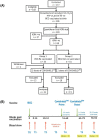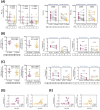This is a preprint.
BCG revaccination qualitatively and quantitatively enhances SARS-CoV-2 spike-specific neutralizing antibody and T cell responses induced by the COVISHIELD™ vaccine in SARS-CoV-2 seronegative young Indian adults
- PMID: 35262071
- PMCID: PMC8902867
- DOI: 10.21203/rs.3.rs-1395683/v1
BCG revaccination qualitatively and quantitatively enhances SARS-CoV-2 spike-specific neutralizing antibody and T cell responses induced by the COVISHIELD™ vaccine in SARS-CoV-2 seronegative young Indian adults
Abstract
This study tested if prior BCG revaccination can further boost immune responses subsequently induced by a widely distributed and otherwise efficacious Oxford/AstraZeneca ChAdOx1nCoV-19 vaccine, referred to as COVISHIELD™, in India. We compared COVISHIELD™ induced longitudinal immune responses in 21 BCG re-vaccinees (BCG-RV) and 13 BCG-non-revaccinees (BCG-NRV), all of whom were BCG vaccinated at birth and latent tuberculosis negative, after COVISHIELD™ prime and boost with baseline samples that were collected pre-pandemic and pre-BCG revaccination. Compared to BCG-NRV, BCG-RV displayed significantly higher magnitude of spike-specific Ab and T cell responses, including a greater proportion of high responders; better quality polyfunctional CD4 and CD8 T cells that persisted and a more robust Ab and T cell response to the Delta mutant of SARS-CoV-2 highlighting greater breadth. Mechanistically, BCG adjuvant effects on COVISHIELD™ induced adaptive responses was associated with more robust innate responses to pathogen-associated-molecular-patterns through TNF-α and IL-1β secretion. This study provides first in-depth analysis of immune responses induced by COVISHIELD™ in India and highlights the potential of using a cheap and globally available vaccine, BCG, as an adjuvant to enhance heterologous adaptive immune responses induced by COVIDSHIELD™ and other emerging vaccines.
Keywords: BCG; CD4; CD8; COVISHIELD™; SARS-CoV-2; antibody binding; heterologous responses; neutralizing antibody; trained immunity.
Conflict of interest statement
Conflict of Interest Statement The authors declare that the research was conducted in the absence of any commercial or financial relationships that could be construed as a potential conflict of interest.
Figures






References
-
- de Castro MJ, Pardo-Seco J, Martinón-Torres F. Nonspecific (Heterologous) Protection of Neonatal BCG Vaccination Against Hospitalization Due to Respiratory Infection and Sepsis. Clin Infect Dis. 2015;60(11):1611–1619. - PubMed
-
- Moorlag SJCF, Arts RJW, van Crevel R, Netea MG. Non-specific effects of BCG vaccine on viral infections. Clin Microbiol Infect. (2019) 25:1473–8. - PubMed
Publication types
Grants and funding
LinkOut - more resources
Full Text Sources
Research Materials
Miscellaneous

